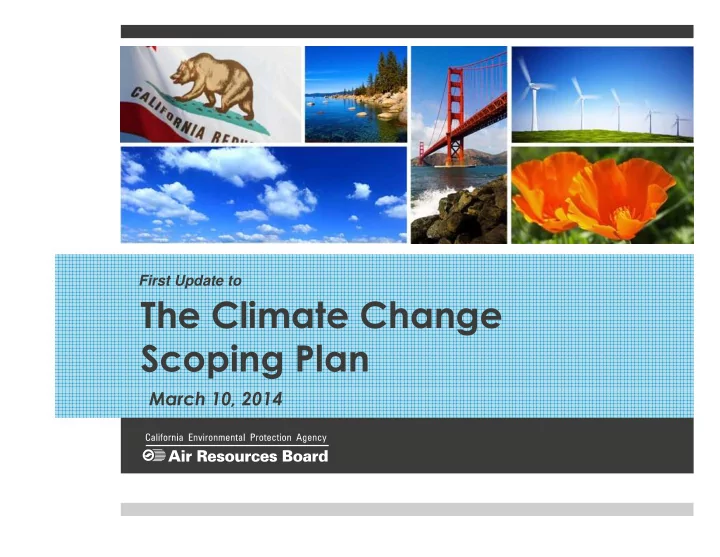

First Update to The Climate Change Scoping Plan March 10, 2014
AB 32 Scoping Plan Update Key Questions ● How have we done over past 5 years ? ● What is needed to continue to 2020 ? ● What steps are needed to continue emission reductions and grow our economy beyond 2020 ? 2
3
Cap-and- Trade program Low Carbon High-Speed Fuel Rail Standard Mandatory Commercial 33% RPS Key Recycling Achievements of Scoping Plan Water Advanced Efficiency Clean Cars California SB 375 Solar Regional Initiative GHG Targets Energy Efficiency Standards 4
Continuing Progress Beyond 2020 Need for a Midterm Target ● Science supports continued reductions ● California’s 2050 goal ● Establishing a 2030 target would: Ensure continued progress toward goal – Provide greater levels of market certainty in the near term – Frame the next suite of emission reduction measures – ● Coordination with Administration, Legislature, stakeholders 5
Sector Recommendations Waste Management Energy Natural & Working Lands Transportation Short Lived Agriculture Climate Pollutants Green Building Water 6
Overarching Recommendations ● Establish statewide mid-term limit as well as sector-specific mid-term targets ● Align strategies to meet air quality and climate change objectives ● Avoid disproportionate impacts to disadvantaged communities ● Plan for zero, near-zero emissions in all sectors ● Continue Cap-and-Trade Program to help meet mid-term and long-term climate goals 7
Recommendations Energy ● Develop a comprehensive GHG emission reduction program for energy by 2016 Coordinate policies, technologies, and investments to cost- – effectively meet mid-term and long-term targets ● Increase energy efficiency, distributed generation/CHP, demand response, and integrated low carbon energy supply 8
Recommendations Transportation ● Reduce light-duty and heavy-duty GHG emissions 5 percent per year to continue progress toward near- zero emissions by 2050 ● Enhance and strengthen LCFS ● Develop Sustainable Freight Strategy ● Leverage investments to achieve both GHG and air quality goals 9
Recommendations Agriculture ● Convene interagency workgroup to: Establish mid-term and long-term planning targets – Provide tools and calculators for GHG emission reduction – best practices Recommend strategies to reduce GHG emissions associated – with energy in agricultural water use ● Interagency dairy digester group to develop recommendations for methane capture standards ● Strengthen technical assistance and associated incentives 10
Recommendations Water ● Convene interagency workgroup to guide adoption of GHG emission reducing policies for water sector investments Include water conservation measures and regulations – ● Identify and incent implementation of rate structures that reflect economic, social, and environmental value of water in California ● Develop comprehensive groundwater management strategies 11
Recommendations Waste Management ● Develop programs to eliminate disposal of organic waste at landfills ● Explore opportunities for additional methane control and increased utilization of captured methane ● Implement financing or incentive mechanisms for in-State infrastructure development 12
Recommendations Natural & Working Lands ● Convene interagency workgroup to develop forest carbon plan that establishes quantitative mid-term and long-term planning targets ● Develop coordinated local land use program ● Expand urban forestry, green infrastructure, and investments ● Strengthen, refine, and implement actions for use of forest biomass ● Convene climate investment working group to outline funding needs and priorities for forests, wetlands and rangelands 13
Recommendations Short-Lived Climate Pollutants ● ARB measures have achieved significant reductions in black carbon ● Current programs reducing HFC emissions ● Efforts underway to achieve further reductions of HFCs and methane emissions ● Develop comprehensive strategy for mitigation of SLCP by 2015 14
Recommendations Green Buildings ● Develop a comprehensive program to reduce GHG emissions from buildings by 2017 New construction – Existing building retrofits – Operation and maintenance of existing green buildings – 15
Next Steps for Update Approval ● March ─ Draft Environmental Analysis (EA) released for public review and comment ● Late April ─ Written comments on Proposed Update and the draft EA are due to ARB ● May ─ Written responses to comments received on draft EA posted to ARB‘s website ● Late May─ Board consideration of final EA, written responses to EA comments, and final Proposed Update 16
Upcoming Major Activities ● Cap-and-Trade Implementation ● Low Carbon Fuel Standard ● Incentives ● Energy 17
Cap-and-Trade Implementation ● Cap-and-Trade program amendments ● Continued development of offsets ● Fuels under the Cap starting January 1, 2015 18
Low Carbon Fuel Standard ● Regulated parties generating credits for current and future compliance ● Credit market is healthy ● 2013 court rulings allow for continued enforcement of the LCFS 19
Incentives ● Enhanced Fleet Modernization Program ● Air Quality Improvement Program ● State budget proposes $200 million for Low Carbon Transportation 20
Fuels and Energy ● Board item on emissions from oil and gas production, processing, and storage ● Ongoing State agency coordination ● Support federal activities: Clean Air Act Section 111(d) 21
Conclusions ● Climate change will require California to: Continue leading the world in effective strategies toward – cleaner, more sustainable economy Continue sharing successful approaches to climate policy – Continue building a State that provides low carbon, high – quality lifestyles ● Set of actions in Proposed Update will: Drive down emissions – Spur innovation in clean and advanced technology – Improve air quality – Create more livable communities – 22
Recommend
More recommend